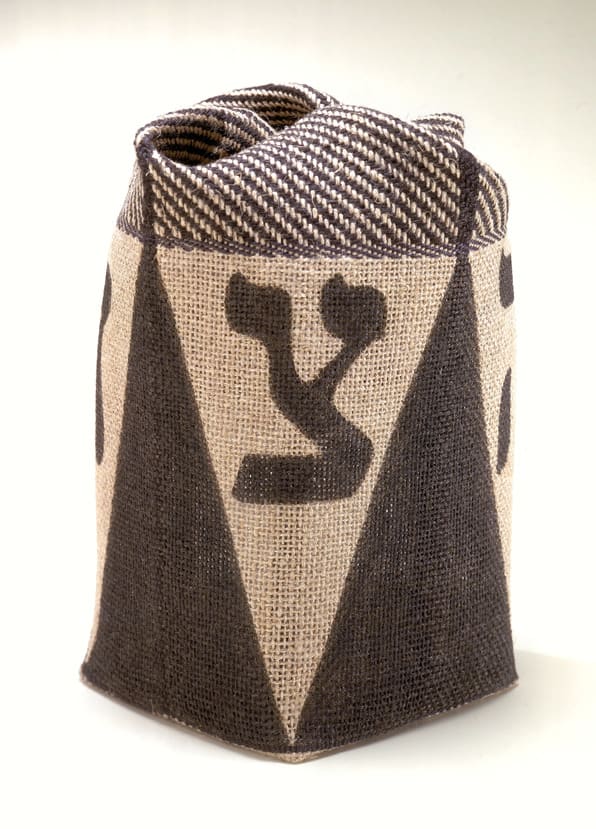
- Object Name:
- Alms Container
- Artist/Maker:
- Kay Sekimachi
- Bio:
- American, b. 1926
- Title:
- Tzedakabako
- Place Made:
- Berkeley, California, United States
- Date:
- 2000
- Medium:
- Linen: hand-woven, painted, stenciled, and dyed
- Dimensions:
- 10 1/4 × 5 1/2 × 5 1/2 in. (26 × 14 × 14 cm)
- Credit Line:
- Purchase: Contemporary Judaica Acquisitions Fund
- Accession Number:
- 2000-76
Not On View
San Francisco-born Kay Sekimachi is an internationally recognized fiber artist. Her work is noted for its innovative forms and delicate sculptural quality. A Japanese American, Sekimachi was sent, along with her mother and two sisters, to an internment camp in Topaz, Utah, under a 1942 order signed by President Franklin Roosevelt, which authorized the incarceration of more than 120,000 Japanese Americans. The camp allowed Sekimachi to paint and draw daily. A fellow detainee and former university art instructor, Chiura Obata, began an art school there. Art supplies arrived for the students, and Sekimachi attended Obata's classes.
After the war, San Francisco became a center for fiber art, and it was there that Sekimachi developed her passion for the medium. She enrolled at the California College of Arts and Crafts to study with Trude Guermonprez, a major figure in weaving and textile arts, who had immigrated to the United States from Germany in the late 1940s. Guermonprez impressed upon Sekimachi the almost limitless potential of the fiber medium, introduced her to intricate weaving techniques, and encouraged her to create nonfunctional works such as tapestries, wall hangings, and room dividers. In 1956, Sekimachi broadened her expertise through study at Haystack Mountain School of Crafts in Deer Isle, Maine, with the celebrated textile designer Jack Lenor Larsen.
Sekimachi's fascination with the box form began in the 1970s with an exhibition of miniature textiles at the British Craft Centre in London. For this exhibition, she created a small loom-woven box. She discovered that the form was highly suitable for a quadruple weave, a technique that integrates four layers of fiber to create the sides of a box. Sekimachi found that the color scheme of black and natural was best for these box shapes, as it allows the viewer to see the form and not be distracted by color.
In 2000, The Jewish Museum commissioned Sekimachi to weave an alms container, which is used in homes and synagogues to collect money for Jewish organizations and charities. She entitled it Tzedakabako-a combination of the Hebrew word for righteousness (tzedakah) and the Japanese word for box (bako). Sekimachi wove the work on a tube and shaped and pressed the ends to create a box form with a folded top. She stenciled the Hebrew letters for tzedakah on the exterior and used a multiple layer weave in black and natural to create a pattern for the folded top, which is unfolded for the insertion of coins and bills.
After the war, San Francisco became a center for fiber art, and it was there that Sekimachi developed her passion for the medium. She enrolled at the California College of Arts and Crafts to study with Trude Guermonprez, a major figure in weaving and textile arts, who had immigrated to the United States from Germany in the late 1940s. Guermonprez impressed upon Sekimachi the almost limitless potential of the fiber medium, introduced her to intricate weaving techniques, and encouraged her to create nonfunctional works such as tapestries, wall hangings, and room dividers. In 1956, Sekimachi broadened her expertise through study at Haystack Mountain School of Crafts in Deer Isle, Maine, with the celebrated textile designer Jack Lenor Larsen.
Sekimachi's fascination with the box form began in the 1970s with an exhibition of miniature textiles at the British Craft Centre in London. For this exhibition, she created a small loom-woven box. She discovered that the form was highly suitable for a quadruple weave, a technique that integrates four layers of fiber to create the sides of a box. Sekimachi found that the color scheme of black and natural was best for these box shapes, as it allows the viewer to see the form and not be distracted by color.
In 2000, The Jewish Museum commissioned Sekimachi to weave an alms container, which is used in homes and synagogues to collect money for Jewish organizations and charities. She entitled it Tzedakabako-a combination of the Hebrew word for righteousness (tzedakah) and the Japanese word for box (bako). Sekimachi wove the work on a tube and shaped and pressed the ends to create a box form with a folded top. She stenciled the Hebrew letters for tzedakah on the exterior and used a multiple layer weave in black and natural to create a pattern for the folded top, which is unfolded for the insertion of coins and bills.
Information may change as a result of ongoing research.